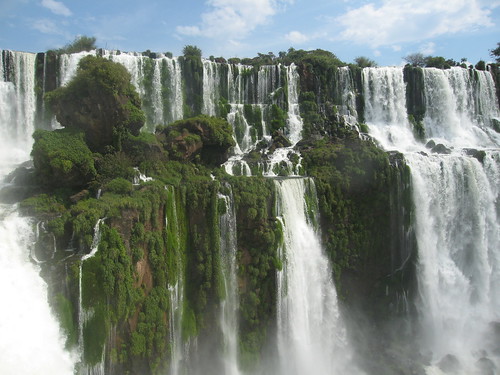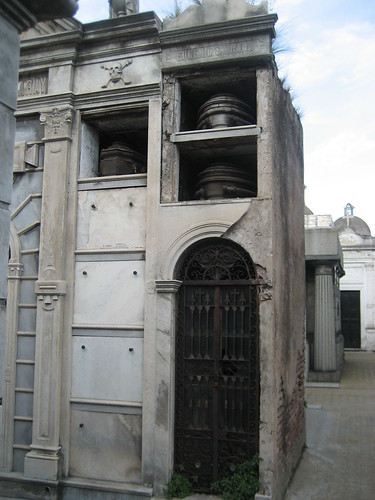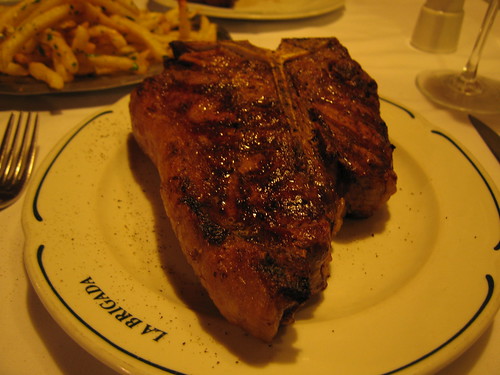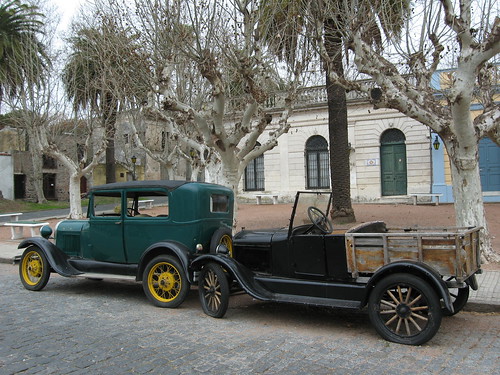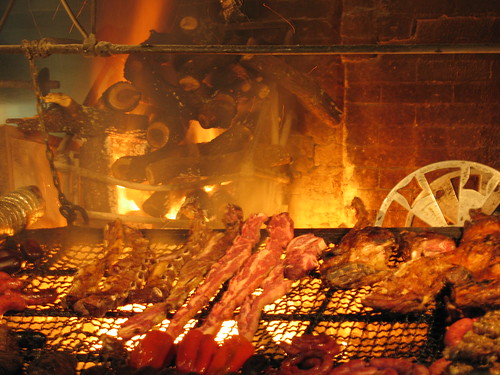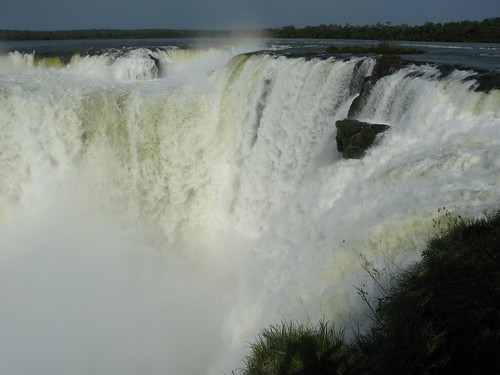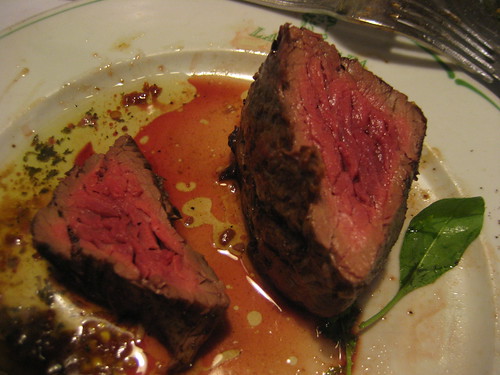Bring on South America...
:: Warning - the following post may disturb Vegetarian readers ::
Setting off for South America was like starting afresh again. Since setting out two years ago we can trace on a map our whole contiguous route over land from Dubrovnik all the way to Cairo. Flying to Argentina was our first deflection from this overland route - a necessary one, but a new beginning to another land journey. The first challenge was getting to grips with the language, the most worrying discovery was that the phase book didn't contain the phrase "medium, rare" an absolute must when ordering that happened daily in the weeks that followed.
There are two ways of getting from Buenos Aires airport to the city, the airport shuttle bus (1 hr) and the local 86 bus (2.5 hours). With time on our side we chose the latter and were treated to a very long ride through every two horse town on the way into the city. Choosing this route soon made us acutely aware of just how sprawling a capital Buenos Aires, is looking out the bus window we wondered would we ever get to the centre. When you do get to the centre the traffic is atrocious, the main bus station, business district and an unbelievably busy container port all lie in close proximity to each other creating a recipe for disaster. It can take an hour to move just a couple of kilometers.
We stayed in the San Telmo area, an artsy quarter with lots of funky cafes, restaurants and antique shops not far from the centre. Over the weekend the whole area came alive with street markets, music and tango dancing on the street. Despite very cold temperatures dancers braved the chill in their scanty little tango dresses - and yes it is true they do just dance in the streets in Buenos Aires. Another interesting area we visited was the gritty old Bocca barrio famous for it's multicoloured buildings and old town vibe.
No trip to Buenos Aires is complete without visiting it's unusual cemetery. Some of it's famous inhabitants include Eva Peron (Evita) however the real draw is the cemetery itself. Most of the coffins are in full view in family crypts. The crypts themselves are in various states of repair, some brand new other is disrepair with ceilings crumbing down in on top of the coffins. It's a very weird place and even more wacky to know that you could technically reach through the bars and touch a coffin. It's definitely not the kind of place you want to be around when it gets dark.
Meat, meat, meat is the mainstay of the Argentinian diet. Parilla restaurants are on every corner, usually with big windows full of different cuts of meat grilling away, street food consists of choripans (sausages) it's definitely a place where you struggle to eat anything else. Our main activity in Buenos Aires was rating steak and red wine restaurants and boy that was an enviable task. Writing this looking back makes my mouth water. We had some of our finest steaks, huge 500g cooked to perfection offerings. One restaurant boasted that it's steaks were so tender and well cooked that you could cut your steak with a spoon - incidentally that was La Brigada and it was one of the best steaks we've ever had. As to be expected red wine is also and area where Argentina excels. For a couple of dollars you can pick up a great one on a supermarket shelf. It's an affordable drink that naturally accompanies dinner rather than an extravagance.
From Buenos Aires we toyed with the idea of heading south towards Patagonia. Plummeting temperatures, insufficient winter clothes and past experience however steered our decision to go north towards the warmer regions. Our next hop was a ferry ride over to Uruguay and to Colonia, a picture perfect seaside town. Colonia looks like a movie set, old buildings housing smart restaurants, mossy cobbled streets, vintage cars abandoned here and there and a ruin or two thrown in for good measure. You can easily see it all walking around it for a couple of hours - or race around in a ridiculous buggy vehicle like many of the tourists did the day we were there.
Montevideo, the capital of Uruguay was next on the itinerary. To be honest our first impressions of the place was a bit "grey and boring". Everything seemed a bit drab, mind you the search for accommodation wasn't going too well and we'd just purchased a hotdog from a street vendor complete with hair, perhaps that had something to do with our outlook. With a bed found and the sun out, the city became all the more attractive. After a bit of wandering we found the nice buildings and beautiful old square. The real charm of Montevideo lies in the area near the port. At present it's the run down largely derelict side of town but surprisingly there are streets and streets of art deco buildings. Our bets are this area will be Montevideo prime real estate of the future.
Lunchtime means meat time... so it was off to the Mercado, a huge factory like building with a smoking chimney containing about twenty different restaurants all serving huge hunks of meat. You walk around grill after grill taking a look at what they've got - usually every conceivable part of the animal. Then you choose an establishment, sit down at a bench and tuck in.
Cities in Argentina are connected by a well serviced network of luxury buses. There's no such thing as the cheap rickety option of getting between two points, actually there's no choice, it's luxury expensive bus or no bus. Bus costs can be frighteningly high, we looked in horror at the cost of getting a few hours up the road and had to remind ourselves that the bus would not only have a soft seat but also the decadence of windows. At the start it felt like out and out flashpacking - far too swish. All the same there are a lot of unnecessary comforts that are no doubt factored significantly into the cost like hot meals and Styrofoam cups of wine.
We bussed north through Argentina to the city of Rosario its claim to fame being the birthplace of Che Guevara. From there it was on to the sleepy town of Posadas, we arrived early on a Sunday morning to find everything closed for the day. Our hotel owner an 87 year old woman pointed us in the direction of a "Tenedor Libre" (all you can eat meat joint). After Sunday lunch we took a stroll along the river front along with the entire population of Posadas along with their mugs and flasks. This naturally brings me to Yerba Mate, the drink of Argentinians and the national pasttime. Everyone and I mean everyone walks around with their own cup made from a gourd, filled to the brim with Yerba and a metal straw to suck it through. In this part of the world it's a social activity and a way of life. To us it was a bizarre and cumbersome addiction, not only do you need to carry a mug and a straw but you need an entire flask of water to keep your cup topped up for the day.
We made a big push north to get to Puerto Iguazu in time for Marcus's birthday. We arrived off a long long bus ride to a welcome wave of tropical heat. At last a chance to retire the thermals and wooly socks! Puerto Iguazu is a big tourist hub and jumping off point to Iguazu Falls which sit on the border of Argentina and Brazil. Usually towns so close to big card draws are not worth hanging around but Puerto Iguazu was an exception. The town itself has a lot of local colour one of the highlights was a market specialising in delicacies. In the evenings local people would pull up and share a selection of olives, cheeses and salamis over a cold beer. A highly civilised afternoon activity.

Sadly my Granny passed away so we found ourselves back in Ireland for her funeral. Our return flight brought us all the way back to Buenos Aires this time we didn't hang around. We stopped long enough for a steak dinner before hopping on an afternoon-overnight bus to Salta in the North of Argentina. Salta is a beautiful city with a pretty little town square, lovely old buildings and plenty of stunning scenery. We spent a day recovering from the bus journey and soaking up the relaxed atmosphere before before departing for "wild west" Humacuaca further north towards the Bolivian border.
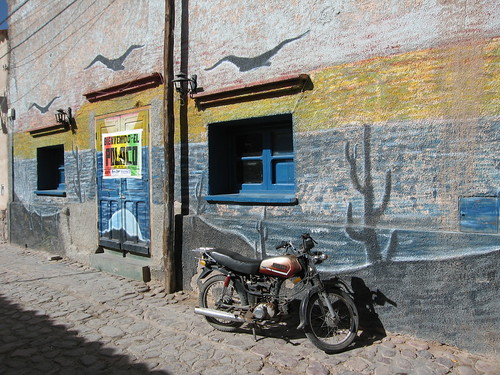
Humacuaca is one of the quirkiest of our stops, it's a tiny picturesque town in the middle of dusty no where. Really all it's got is an old train yard, a bus station, cute cobbled streets, a grassy town square and clock tower. Picture dust, tumbleweed and the odd cactus. The clock tower is unique; at twelve o'clock daily a life size monk emerges from a cuckoo clock, makes the sign of the cross and disappears until the following day. His daily appearance is pretty much the highlight of the town. We chanced giving it a miss in favour of catching the 8am bus to the Bolivian border a few hours north. A marching band trumpeting in the street at the crack of dawn had us up early anyhow.
There are two ways of getting from Buenos Aires airport to the city, the airport shuttle bus (1 hr) and the local 86 bus (2.5 hours). With time on our side we chose the latter and were treated to a very long ride through every two horse town on the way into the city. Choosing this route soon made us acutely aware of just how sprawling a capital Buenos Aires, is looking out the bus window we wondered would we ever get to the centre. When you do get to the centre the traffic is atrocious, the main bus station, business district and an unbelievably busy container port all lie in close proximity to each other creating a recipe for disaster. It can take an hour to move just a couple of kilometers.
We stayed in the San Telmo area, an artsy quarter with lots of funky cafes, restaurants and antique shops not far from the centre. Over the weekend the whole area came alive with street markets, music and tango dancing on the street. Despite very cold temperatures dancers braved the chill in their scanty little tango dresses - and yes it is true they do just dance in the streets in Buenos Aires. Another interesting area we visited was the gritty old Bocca barrio famous for it's multicoloured buildings and old town vibe.
No trip to Buenos Aires is complete without visiting it's unusual cemetery. Some of it's famous inhabitants include Eva Peron (Evita) however the real draw is the cemetery itself. Most of the coffins are in full view in family crypts. The crypts themselves are in various states of repair, some brand new other is disrepair with ceilings crumbing down in on top of the coffins. It's a very weird place and even more wacky to know that you could technically reach through the bars and touch a coffin. It's definitely not the kind of place you want to be around when it gets dark.
Meat, meat, meat is the mainstay of the Argentinian diet. Parilla restaurants are on every corner, usually with big windows full of different cuts of meat grilling away, street food consists of choripans (sausages) it's definitely a place where you struggle to eat anything else. Our main activity in Buenos Aires was rating steak and red wine restaurants and boy that was an enviable task. Writing this looking back makes my mouth water. We had some of our finest steaks, huge 500g cooked to perfection offerings. One restaurant boasted that it's steaks were so tender and well cooked that you could cut your steak with a spoon - incidentally that was La Brigada and it was one of the best steaks we've ever had. As to be expected red wine is also and area where Argentina excels. For a couple of dollars you can pick up a great one on a supermarket shelf. It's an affordable drink that naturally accompanies dinner rather than an extravagance.
From Buenos Aires we toyed with the idea of heading south towards Patagonia. Plummeting temperatures, insufficient winter clothes and past experience however steered our decision to go north towards the warmer regions. Our next hop was a ferry ride over to Uruguay and to Colonia, a picture perfect seaside town. Colonia looks like a movie set, old buildings housing smart restaurants, mossy cobbled streets, vintage cars abandoned here and there and a ruin or two thrown in for good measure. You can easily see it all walking around it for a couple of hours - or race around in a ridiculous buggy vehicle like many of the tourists did the day we were there.
Montevideo, the capital of Uruguay was next on the itinerary. To be honest our first impressions of the place was a bit "grey and boring". Everything seemed a bit drab, mind you the search for accommodation wasn't going too well and we'd just purchased a hotdog from a street vendor complete with hair, perhaps that had something to do with our outlook. With a bed found and the sun out, the city became all the more attractive. After a bit of wandering we found the nice buildings and beautiful old square. The real charm of Montevideo lies in the area near the port. At present it's the run down largely derelict side of town but surprisingly there are streets and streets of art deco buildings. Our bets are this area will be Montevideo prime real estate of the future.
Lunchtime means meat time... so it was off to the Mercado, a huge factory like building with a smoking chimney containing about twenty different restaurants all serving huge hunks of meat. You walk around grill after grill taking a look at what they've got - usually every conceivable part of the animal. Then you choose an establishment, sit down at a bench and tuck in.
Cities in Argentina are connected by a well serviced network of luxury buses. There's no such thing as the cheap rickety option of getting between two points, actually there's no choice, it's luxury expensive bus or no bus. Bus costs can be frighteningly high, we looked in horror at the cost of getting a few hours up the road and had to remind ourselves that the bus would not only have a soft seat but also the decadence of windows. At the start it felt like out and out flashpacking - far too swish. All the same there are a lot of unnecessary comforts that are no doubt factored significantly into the cost like hot meals and Styrofoam cups of wine.
We bussed north through Argentina to the city of Rosario its claim to fame being the birthplace of Che Guevara. From there it was on to the sleepy town of Posadas, we arrived early on a Sunday morning to find everything closed for the day. Our hotel owner an 87 year old woman pointed us in the direction of a "Tenedor Libre" (all you can eat meat joint). After Sunday lunch we took a stroll along the river front along with the entire population of Posadas along with their mugs and flasks. This naturally brings me to Yerba Mate, the drink of Argentinians and the national pasttime. Everyone and I mean everyone walks around with their own cup made from a gourd, filled to the brim with Yerba and a metal straw to suck it through. In this part of the world it's a social activity and a way of life. To us it was a bizarre and cumbersome addiction, not only do you need to carry a mug and a straw but you need an entire flask of water to keep your cup topped up for the day.
We made a big push north to get to Puerto Iguazu in time for Marcus's birthday. We arrived off a long long bus ride to a welcome wave of tropical heat. At last a chance to retire the thermals and wooly socks! Puerto Iguazu is a big tourist hub and jumping off point to Iguazu Falls which sit on the border of Argentina and Brazil. Usually towns so close to big card draws are not worth hanging around but Puerto Iguazu was an exception. The town itself has a lot of local colour one of the highlights was a market specialising in delicacies. In the evenings local people would pull up and share a selection of olives, cheeses and salamis over a cold beer. A highly civilised afternoon activity.

:: " Don't mind if I do " ::
Of course everyone is in Iguazu for one reason and one reason only - to see the magnificent Iguazu waterfalls. They do not disappoint, they are literally jawdroppingly amazing. We visited from the Argentinean side where a park of pathways designed to have minimum impact on the environment leads you to different vistas and aspects of the wide cascade of waterfalls. Iguazu Falls is a series of different waterfalls so climbing the walkways took us over and under the falls. For the thrill seeker you can take a boat ride straight under the falls - thus simulating a torrential rain shower. We found the best view was from the island close to the falls. We left the most impressive of the falls, the Devil's Mouth as the last stop of the day. To get there you take a train and walk out along a platform over a wide river several hundred metres wide. The scary thing is that the river flows innocuously not giving you any indication of the huge violent drop off around the corner. Standing watching an awesome amount of water careering over the edge of Devil's Mouth was an spectacular sight.Sadly my Granny passed away so we found ourselves back in Ireland for her funeral. Our return flight brought us all the way back to Buenos Aires this time we didn't hang around. We stopped long enough for a steak dinner before hopping on an afternoon-overnight bus to Salta in the North of Argentina. Salta is a beautiful city with a pretty little town square, lovely old buildings and plenty of stunning scenery. We spent a day recovering from the bus journey and soaking up the relaxed atmosphere before before departing for "wild west" Humacuaca further north towards the Bolivian border.

Humacuaca is one of the quirkiest of our stops, it's a tiny picturesque town in the middle of dusty no where. Really all it's got is an old train yard, a bus station, cute cobbled streets, a grassy town square and clock tower. Picture dust, tumbleweed and the odd cactus. The clock tower is unique; at twelve o'clock daily a life size monk emerges from a cuckoo clock, makes the sign of the cross and disappears until the following day. His daily appearance is pretty much the highlight of the town. We chanced giving it a miss in favour of catching the 8am bus to the Bolivian border a few hours north. A marching band trumpeting in the street at the crack of dawn had us up early anyhow.
Read more...

